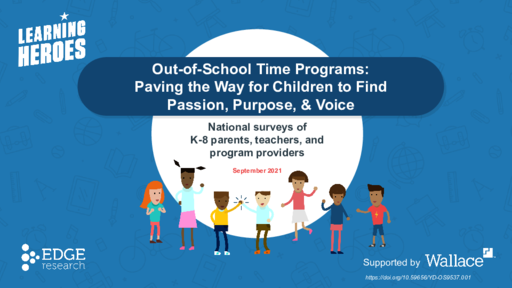Back to Overview
Out-of-School Time Programs
Table of Contents
- Author(s)
- Pam Loeb, Stacia Tipton, Erin Wagner, Lynn Olson, Bibb Hubbard, Windy Lopez-Aflitto, and David Park
- Publisher(s)
- Learning Heroes and Edge Research
Page Count
51 pages
Implementation Tips
Program providers, educators, and advocates can use the report to communicate about the value of out-of-school-time programs, focusing on what parents value most.
- Life Skills + Child-Centered: Emphasize how programs expose children to new experiences, ideas, and perspectives beyond their everyday home and school lives, and help them find their passion, purpose, and voice. Emphasize that children develop social skills, teamwork, confidence, respect, and self-esteem through OST programs.
- Social and Emotional: Highlight that programs are fun, safe, nurturing, and welcoming.
- Academic Benefits: Parents connect program participation with academic outcomes. Across race, ethnicity, and income groups, parents with a child in an OST program report their child is getting higher grades and doing better academically than parents of non-participants, and they are more confident their child is prepared for the next school year.
- Role of Staff Support: Explain clearly how staff supports the development of children’s skills and experiences in a fun, safe, and nurturing environment.
- Speak to Your Specific Audience: Parents of middle school children look for programs to develop leadership skills more than parents of younger children do. Black and Latino/a parents rate communications skills in the top tier of importance.
- Highlight Accessibility: Communicate the quality features of free and low-cost programs and use equitable strategies that engage families to sign up for and access these programs. Address barriers such as fees, meals, transportation, and waiting lists.

